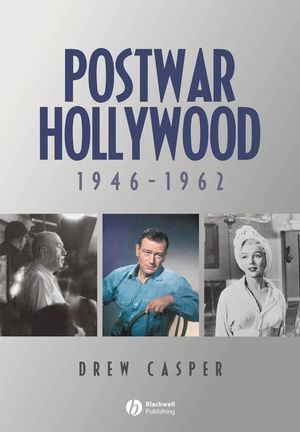|
Textbook
Postwar Hollywood: 1946-1962ISBN: 978-1-4051-5075-0
Paperback
496 pages
September 2007, ©2007, Wiley-Blackwell
 This is a Print-on-Demand title. It will be printed specifically to fill your order. Please allow an additional 10-15 days delivery time. The book is not returnable.
|
||||||
Part I: Cultural Overview:The Years of Change in America, 1946--1962:.
Introduction.
1. Major Historical Events.
Introduction.
1.1 The Cold War.
1.2 Civil Rights.
Conclusion.
2. Economic Situation.
Introduction.
1.1 Economic Resurgence.
1.2 Post-Industrial Society.
Conclusion.
3. Societal Issues.
Introduction.
3.1 Consumer Culture and Middle-Classness.
3.2 The American Male.
3.3 The American Female.
3.4 The American Family.
3.5 Juvenile Delinquency.
3.6 Sensuality, Sex, and Violence.
3.7 Social Morality.
3.8 Crime.
3.9 Religion.
Conclusion.
4. Other Popular Leisure Activities.
Introduction.
4.1 Television.
4.2 Recordings and Radio.
4.3 Theater.
4.4 Adult Popular Fiction.
4.5 Sports, Travel, and Home Improvement.
Conclusion.
Part II: Business:.
Introduction.
5. Production and Distribution.
Introduction.
5.1 The Antitrust Suit Wrap-up and Fallout.
5.2 The Loss of the Audience.
5.3 The Decline and Shift in Product.
5.4 Consolidation.
5.5 The Mode of Independent Production.
5.6 Runaway Production.
5.7 Diversification.
5.8 Company Profiles: The Administrative and Financial Picture.
5.9 The Industry and HUAC.
5.10 Distribution Practices.
6. Exhibition.
Conclusion.
Part III: Technology:.
Introduction.
7. Color.
7.1 Ansco Color and Metrocolor.
7.2 Eastman Color, Warnercolor, Color By Deluxe, Columbia Color.
7.3 Trucolor by Consolidated and Cinecolor/Natural Color/Super Cinecolor.
8. Screen Shapes and Accompanying Sound Systems.
8.1 Multi-Camera Systems.
8.2 Anamorphic Systems.
8.3 Widescreen.
8.4 Wide-Frame Systems.
8.5 The 70mm/Wide-Gauge Processes.
9. Three-Dimension, Special Effects, and Film Production Refinements.
9.1 3-D.
9.2 Special Effects.
9.3 Film Production Refinements.
Conclusion.
Part IV: Censorship:.
Introduction.
10. Test Cases.
10.1 The Outlaw (UA, 1946/RKO, 1950).
10.2 The Jane Russell Syndrome: Rita Hayworth, Marilyn Monroe, Cyd Charisse, Sophia Loren, and Gina Lollobrigida.
10.3 The Adaptation of Controversial and Sensational Novels: Double Indemnity (P, 1944), Leave Her To Heaven (TCF, 1945), The Postman Always Rings Twice (MGM, 1946), Duel In the Sun (SRO, 1946), Forever Amber (TCF, 1947), and Flamingo Road (WB, 1949).
10. 4 Racism: Pinky (TCF, 1949) and Curley (UA, 1947).
10.5 The Bicycle Thief (1949).
10.6 Stromboli (1950).
10.7 The Miracle (1950) and the US Supreme Court Decision of 1952.
10.8 Detective Story (P, 1951), Beyond the Forest (WB, 1949), The Doctor and the Girl (MGM, 1949), A Place In the Sun (P, 1951), People Will Talk (TCF, 1952), and Code Amendments of 1951.
10.9 The Moon Is Blue (UA, 1953).
10.10 The French Line (RKO, 1953).
10.11 From Here To Eternity (C, 1953).
10.12 Shurlock’s Reign and Code Readjustments of 1954; La Ronde (1950, 1951) and M (C, 1951).
10.13 Backlash; The Man With the Golden Arm (UA, 1955) and Picnic (C, 1955).
10.14 The Code Revision of 1956.
10.15 Baby Doll (WB, 1956), Tea and Sympathy (MGM, 1956), and The Bad Seed (WB, 1956).
10.16 Giant (WB, 1956), Serenade (WB, 1956), Island In the Sun (TCF, 1957), and Sayonara (WB, 1957).
10.17 Legion Expansion: Peyton Place (TCF, 1957).
10.18 Roth vs. US and The Game of Love (1954); The Garden of Eden (Excelsior Pictures, 1957).
10.19 Vertigo (P, 1958), Bonjour Tristesse (C, 1958), and Cat On A Hot Tin Roof (MGM, 1958).
10.20 Lady Chatterley's Lover (1957), And God Created Woman (1958), Room At the Top (1959), and Never On Sunday (1960).
10.21 Anatomy of a Murder (C, 1959).
10.22 Suddenly Last Summer (C, 1959), Some Like It Hot (UA, 1959), and Pillow Talk (U, 1959).
10.23 Blue Denim (TCF, 1959) and A Summer Place (WB, 1959).
10.24 Happy Anniversary (UA, 1959).
10.25 Elmer Gantry (UA, 1960).
10.27 Sanctuary (TCF, 1961) and Splendor In the Grass (WB, 1961).
10.28 Lolita (MGM, 1962) and the Code Amendment of 1961.
10.29 Don Juan (1959).
Conclusion.
Part V: Genre:.
Introduction.
11. Adventure.
12. Biography.
13. Historical Spectacle.
14. Comedy.
14.1 Social Satire.
14.2 Farce.
14.3 Romantic Comedy.
14.4 Family Comedy.
14.5 Fantasy Comedy.
14.6 Comedian Comedy.
14.7 Black Comedy.
14.8 Parody.
15. Horror, Science Fiction, and Fantasy.
15.1 Horror--Science Fiction.
15.2 AIP Teenage Horror.
15.3 Modern Horror.
15.4 Science Fiction.
15.5 Fantasy.
16. Melodrama.
16.1 Family Melodrama.
16.2 Female Melodrama.
16.3 Male Melodrama.
16.4 Romance Melodrama.
17. Musical.
17.1 Musical Comedy and Musical Drama.
17.2 Musical Biography.
18. Social Problem Film and Courtroom Drama.
18.1 Social Problem Film.
18.2 Courtroom Drama.
19. Suspense Thriller.
19.1 World War II and Cold War Thriller.
19.2 Crime Thriller: Lawmen and Criminals.
19.3 Social Problem Thriller.
20. War.
21. Western.
Conclusion.
Part VI: Style:.
Introduction.
22. Noir.
Introduction.
22.1 Determinations and Practitioners.
22.2 Noir and Genre.
22.3 Mode of Representation and Attitude of Mind.
23. Documentary Realism and Psychological-Sociological Realism.
Introduction.
23.1 Determinations of a Deeper Realism.
23.2 Documentary Realism: Determinations and Practitioners.
23.3 Psychological-Sociological Realism: Determinations and Practitioners.
23.4 Mode of Representation and Attitude of Mind.
24. Other Stylistic Devices.
Conclusion.
25. Coda.
Select Bibliography.
Appendix: Hierarchical Order of Postwar Hollywood’s Top Ten Box-Office Stars (1946—62).
Index



